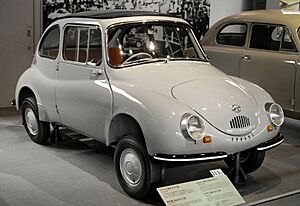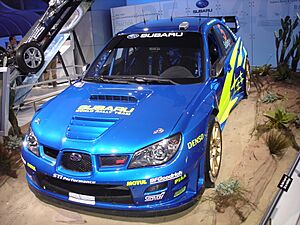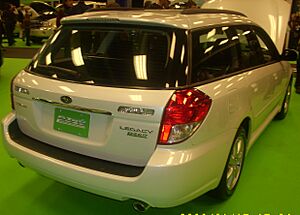Subaru facts for kids
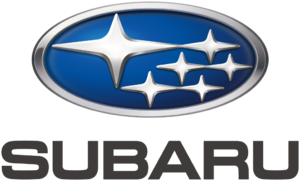
Logo since 2019
|
|
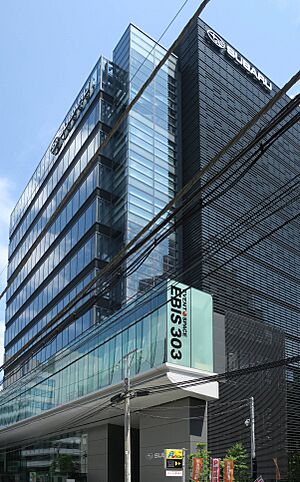
Headquarters
|
|
|
Native name
|
スバル
|
|---|---|
| Division | |
| Industry | Automotive |
| Predecessor | Nakajima Aircraft Company |
| Founded | 15 July 1953 |
| Founder | Kenji Kita Chikuhei Nakajima |
| Headquarters |
Ebisu, Shibuya
,
Japan
|
|
Area served
|
Worldwide |
|
Key people
|
Atsushi Osaki (president, Representative Director & CEO) Tomomi Nakamura (chairman & director) |
| Products | Automobiles |
|
Production output
|
|
| Parent | Subaru Corporation |
| Divisions | Subaru Tecnica International |
Subaru (スバル, /ˈsuːbəruː/ or /sʊˈbɑːruː/; Japanese pronunciation: [sɯꜜbaɾɯ]) is a Japanese company that makes cars. It is a part of a bigger company called Subaru Corporation. This company used to be known as Fuji Heavy Industries. In 2017, Subaru was one of the largest car makers in the world.
Subaru cars are well-known for using a special type of engine called a boxer engine. Most of their cars bigger than 1,500 cubic centimeters have this engine. Subaru also introduced a special four-wheel-drive system called Symmetrical All Wheel Drive in 1972. By 1996, both the boxer engine and this all-wheel-drive system became standard in most of their mid-size and smaller cars. One car, the Subaru BRZ, is different. It was made in 2012 with Toyota and uses the boxer engine but has rear-wheel-drive. Subaru also makes powerful versions of their cars with turbocharged engines, like the Subaru WRX and Outback XT.
In countries like the United States and Europe, Subaru cars have a small but very loyal group of buyers. The company's advertising often focuses on its unique engine, all-wheel-drive system, and ability to handle rough roads. They also offer sports car designs that are affordable.
The name Subaru means the Pleiades star cluster in Japanese. This star cluster is also known as the "Seven Sisters." The Subaru logo shows six stars, because one of the "sisters" is traditionally said to be invisible. This star theme connects to the companies that joined together to form Fuji Heavy Industries.
Contents
Subaru's Journey: From Airplanes to Cars
How Subaru Began: Fuji Heavy Industries
The company that would become Subaru started in 1915 as the Aircraft Research Laboratory. It was led by Chikuhei Nakajima. In 1932, it became Nakajima Aircraft Company, Ltd. This company soon became a major maker of airplanes for Japan during World War II.
After the war ended, Nakajima Aircraft changed its name to Fuji Sangyo Co, Ltd. In 1946, the company made the Fuji Rabbit, a motor scooter. They used spare airplane parts to build it. In 1950, Fuji Sangyo was split into 12 smaller companies. This happened because of a Japanese government law.
Between 1953 and 1955, five of these smaller companies and one new company decided to join together. They formed Fuji Heavy Industries. These companies included:
- Fuji Kogyo, which made scooters.
- Fuji Jidosha, which built car bodies.
- Omiya Fuji Kogyo, an engine maker.
- Utsunomiya Sharyo, which built car frames.
- Tokyo Fuji Sangyo, a trading company.
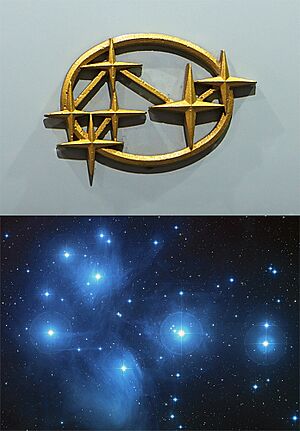
Kenji Kita, who was the CEO of Fuji Heavy Industries at the time, wanted the new company to make cars. He started planning to build a car with the code-name P-1. Kita asked for name ideas for the P-1, but he didn't like any of them. In the end, he chose a Japanese name he loved: Subaru. This is the Japanese name for the Pleiades star cluster.
The very first Subaru car was called the Subaru 1500. Only twenty of these cars were made because of problems getting parts. After that, the company designed and built many other vehicles. These included the tiny air-cooled Subaru 360 (1958), the Subaru Sambar (1961), and the Subaru 1000 (1965). The Subaru 1000 was important because it was the first car to use Subaru's boxer engine.
Working with Other Companies: Later Partnerships
In 1968, Nissan bought a part of Fuji Heavy Industries. This happened because the Japanese government wanted car companies to work together more. Nissan used FHI's skills to build buses for their Nissan Diesel line. Many Subaru cars, even today, use parts from Nissan's group of companies. For example, the Subaru automatic transmission, called the 4EAT, was also used in the first Nissan Pathfinder.
While working with Nissan, Subaru introduced many new cars. These included the Subaru R-2 (1969), the Subaru Rex and Subaru Leone (1971), the Subaru BRAT (1978), the Subaru Legacy (1989), the Subaru Impreza (1993), and the Subaru Forester (1997).
In 1999, Nissan sold its share of FHI to General Motors (GM). During this time, Subaru launched the Subaru Baja (2003) and the Subaru Tribeca (2005). Some Subaru cars were even sold under different brand names. For example, the Subaru Forester was sold as a Chevrolet Forester in India. Also, a Subaru Impreza was sold in the United States as the Saab 9-2X.
GM sold its shares in FHI in 2005. Then, Toyota Motors bought some of GM's shares, which was about 8.7% of FHI. Since then, Toyota and Subaru have worked together on several projects. One example is building the Toyota Camry in Subaru's factory in Indiana, USA, starting in 2007. Subaru also introduced the Subaru Exiga in 2008.
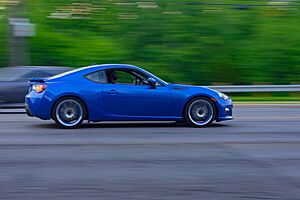
Toyota increased its share of FHI in 2008. After that, Toyota and Subaru worked together to create the Subaru BRZ. This car was first sold in 2012. Toyota sold the BRZ as the Scion FR-S for a while, and then as the Toyota 86. Around this time, Subaru also decided to stop making their own small "Kei cars" and trucks. Instead, they started selling rebadged versions from Toyota's Daihatsu company. This allowed Subaru, which is a smaller car maker, to focus on their main cars with boxer engines. Subaru's last own-made Kei vehicle was the sixth-generation Subaru Sambar, which stopped production in 2012. In 2022, Subaru launched the Solterra, which is an electric SUV similar to the Toyota bZ4X.
How Subaru Advertises Its Cars
Subaru has used many different advertising slogans over the years. Some of these include:
- "The World's Favourite Four Wheel Drive" (in the UK)
- "We built our reputation by building a better car"
- "Confidence in Motion" (USA, early 2010s)
- Currently, in North America, their slogan is "Love. It's what makes Subaru, Subaru."
In the 1990s, Subaru learned that their all-wheel-drive cars were popular with certain groups of buyers. The company then started to include subtle marketing messages for these groups.
According to Automotive Lease Guide, Subaru cars have high predicted resale values. This means they hold their value well over time. A study by J.D. Power and Associates in 2008 showed that Subaru had a good customer retention rate, meaning many customers bought another Subaru.
Subaru also worked with Gainax to create an animation series called Wish Upon the Pleiades. This series was released on YouTube in 2011. It was a "magical girl" story with Subaru as a main character.
Where Subaru Works Today
Subaru's main offices are in Ebisu, Tokyo, Japan.
Subaru's Car Factories
Subaru is different from many other Japanese car companies. As of early 2016, almost 75% of the cars they sold around the world were still made in Japan. Subaru's car factories in Japan are located in Ōta, Gunma Prefecture. There are four main locations:
- Subaru-chō: This is where the Subaru BRZ/Toyota 86 is built.
- Yajima Plant: All current Subaru cars are built here.
- Otakita Plant: This factory builds commercial Kei trucks.
- Oizumi Plant: Located in Oizumi, this is where engines and transmissions are made.
Subaru also has a big factory outside Japan in Lafayette, Indiana, USA. This factory is called Subaru of Indiana Automotive, Inc.. Because more and more Subaru cars are being sold in North America, this factory is expanding to make 390,000 vehicles each year. By the end of 2016, Subaru planned to make over 1 million vehicles worldwide each year.
Subaru in Asia
In some Asian countries outside Japan, a company called Motor Image Group supplies Subaru cars, parts, and accessories.
Subaru started selling cars in the Philippines in 1996. After a break, the brand came back in 2006 under new management. Subaru now has seventeen dealerships across the country. Their SUV models, like the Subaru Forester and Subaru XV, have become very popular there.
Subaru cars have been sold in China since 2004. In 2011, Subaru and a Chinese car maker called Chery wanted to build a factory together in China. However, the Chinese government did not approve this plan. This was because Subaru's partner, Toyota, already had two factories in China, which was the maximum allowed.
Subaru also had a presence in South Korea, starting in 2009. Sales began in 2010 with the Legacy, Outback, and Forester models. However, by 2012, Subaru Korea decided to stop selling new car models because sales were low.
On April 23, 2019, Subaru officially opened a new factory in Lat Krabang, Bangkok, Thailand. This factory is a joint project between Subaru Corporation and Tan Chong International. The plant used to be a Mitsubishi Fuso factory. It now makes Subaru vehicles for markets in Asia, including Australia and New Zealand. The factory can make up to 100,000 vehicles per year. In 2019, they planned to make 6,000 Forester models.
Since February 2020, PT Plaza Auto Mega has supported Subaru in Indonesia.
Subaru in the United Kingdom
In 1974, a person named Robert Edmiston started a company called International Motors. This company got the right to sell Subaru and Isuzu cars in the UK. This company, based in Coleshill, Warwickshire, still handles Subaru in the UK today.
Subaru in Australia
Subaru cars have been in Australia since the mid-1950s. Official operations began in 1973, and there are now many Subaru showrooms across the country.
Subaru in the United States
Subaru of America (SOA) was started in 1968 by Malcolm Bricklin and Harvey Lamm. It moved its headquarters several times and is now in Camden, New Jersey. Fuji Heavy Industries (now Subaru Corporation) took full ownership of SOA in 1990. SOA has offices and parts centers all over the United States.
In 1989, Subaru and its partner Isuzu opened a factory together in Lafayette, Indiana. It was called Subaru-Isuzu Automotive, or SIA. This factory first made the Subaru Legacy and Isuzu Rodeo. In 2001, Isuzu sold its part of the factory to Fuji Heavy Industries. The factory was then renamed Subaru of Indiana Automotive, Inc.. This factory is special because it was the first car assembly plant in the United States to send nothing to a landfill. It has also been named a wildlife habitat by the National Wildlife Federation.
Subaru in Racing: Motorsports
| Formula One World Championship career | |
|---|---|
| First entry | 1990 United States Grand Prix |
| Last entry | 1990 British Grand Prix |
| Races entered | 8 |
| Chassis | Coloni |
Subaru Rally Team Japan raced Subaru cars in the World Rally Championship from 1980 to 1989. Drivers like Ari Vatanen and Per Eklund competed for them. In 1986, Mike Kirkland finished 6th overall and won his group at the Safari Rally. Subaru was one of the few car makers using both four-wheel-drive and turbo engines at that time.
Later, special versions of the Subaru Impreza WRX and Subaru Impreza WRX STi became very successful in rallying. Drivers like Colin McRae (1995), Richard Burns (2001), and Petter Solberg (2003) won World Rally Championship titles with the Subaru World Rally Team. Subaru also won the manufacturers' title three years in a row from 1995 to 1997. The Prodrive team, a British motorsport group, prepares and runs Subaru's World Rally Championship cars.
Subaru was briefly involved in Formula One racing in 1990. They bought a part of a small Italian team called Coloni. The Coloni car's engine was called a Subaru engine, but it was too heavy and not powerful enough. The partnership ended before the season was over.
In the US, the Subaru Impreza WRX became very popular in 2001. It helped bring high-performance all-wheel-drive cars into the mainstream sports car world. Subaru Rally Team USA has won the driver's title in Rally America six times, most recently in 2011 with David Higgins.
Since 2005, Cusco Racing has raced an Impreza and a Subaru BRZ in the Super GT championship. In 2008, the Impreza was the first four-door and first four-wheel-drive car to win a race in that series.
On December 16, 2008, Subaru announced that it would no longer compete in the World Rally Championships. This decision was made by Subaru's parent company, Fuji Heavy Industries. It was partly due to the economic situation.
In 2011, Mark Higgins used a standard Impreza to set a lap record at the Isle of Man TT course. In 2016, Higgins broke his own record in a modified WRX STI.
In 2012, Subaru also became a sponsor for Australia's main road cycling competition, the National Road Series. Subaru cars, especially the Impreza, have also won famous hillclimb races like the Silverstone Race to the Sky.
Subaru's EyeSight System
In 2008, Subaru introduced its EyeSight collision avoidance system. This system helps drivers avoid accidents. Unlike many other systems that use radar, EyeSight uses two cameras placed at the top of the windshield. These cameras work like human eyes to see how far away other cars are. This helps with features like automatic braking before a crash and adaptive cruise control. Studies have shown that early versions of EyeSight reduced rear-end crashes with injuries by 85%. They also reduced pedestrian injuries by 35%.
As of 2022, Subaru had sold 5 million cars with the EyeSight system. In the U.S., EyeSight is now standard on most Subaru models with automatic transmissions.
| Version | Launch Date | Technology Changes & Notes | Adaptive Cruise | Lane Departure Systems | Pre-collision Braking | Rear Radar Features |
|---|---|---|---|---|---|---|
| Eyesight Gen 1 | 2008 (Japan-only) | Hitachi manufactured Front-facing stereoscopic greyscale cameras (x2) |
N/A | N/A | N/A | N/A |
| Eyesight Gen 2 | 2012 (2013 MY) | Improved overall performance | Operates from 0–100 km/h (0–62 mph) | Warns during lane sway or departure | 30 km/h (19 mph) maximum speed differential for braking | N/A |
| Eyesight Gen 3 | 2014 (2015 MY) | Front-facing cameras updated, now color Lower profile in vehicle for improved stray light rejection Adds rear radar option |
Adds "Lane Keeping Assist" to gently steer inside lanes if speed is above 65 km/h (40 mph) | Applies torque to center the vehicle if unsignaled lane change occurs | Improved speed differential for braking if speed is under 50 km/h (31 mph) New cameras increase range and viewing angle by ~40% Throttle management added for reversing |
Adds rear cross traffic alerts, blind spot detection, and lane change warnings. |
| Eyesight Gen 4 | 2021 (MY 2022) | New camera system from Veoneer, core CPU from Xilinx Camera body has integrated heater and cooling fans, lens housing now flush to windshield. Optional third front-facing wide-range mono camera (some models) |
Wider angle camera for smoother cruise around sharp curves | Improved performance | Adds Automatic Emergency Steering, if speed is under 80 km/h (50 mph) Adds electronic brake booster Optional wide-angle camera improves pedestrian and bike detection |
If included, enables Automatic Emergency Steering for collision prevention |
| Eyesight X | No North America Release (2020 Japan / Europe-only on Levorg) |
Based on Gen 4 Platform Adds front-facing 77 GHz MW wave radar Adds front corner radars |
||||
| Eyesight Gen 5 | 2026+ | AMD Versal AI Edge Series (Gen 2) SOC, onsemi Hyperlux AR0823AT Sensors |
||||
|
Legend:
Old version
Latest version
Future release
|
||||||
Subaru's Technology and Fuel Use
Diesel Engines
At the Frankfurt International Motor Show in 2007, Subaru showed off a new type of diesel engine. It was a horizontally opposed (boxer) turbodiesel engine. This was the first time this type of diesel engine was put into a passenger car.
This Subaru engine produced 110 kW (150 PS; 148 hp) of power. It had a size of 2.0 liters. In March 2008, Subaru started offering the Legacy Sedan and Wagon and the Outback Wagon with this 2.0 liter turbodiesel engine in Europe.
In September 2008, Subaru announced that diesel versions of the Forester and Impreza would be introduced. The Forester and Impreza diesel models came with a 6-speed manual transmission.
Electric Cars
In June 2006, Fuji Heavy Industries (FHI) launched the Subaru Stella Plug-in electric vehicle. This was a small "Kei car" with a lithium-ion battery. It had a short range of 56 miles (90 km).
In Japan, Subaru tested two electric vehicles, the Subaru R1e and Subaru G4e, between 2003 and 2009.
The Subaru Hybrid Tourer Concept is a car that combines a 2-liter turbocharged gasoline engine with two electric motors. It uses a lithium-ion battery to store energy.
In early 2018, Subaru joined a project called EV C.A. Spirit. This project, started by Toyota, Mazda, and Denso, aims to work together on developing electric vehicle technology.
In the U.S., the Crosstrek hybrid was sold from 2014 to 2017. In 2018, Subaru introduced the Crosstrek Plug-in Hybrid. This car uses a lot of technology from Toyota's Prius Prime. It can travel 17 mi (27 km) on electric power alone. It is mainly sold in California and parts of the East Coast.
Subaru's first all-electric car is called the Subaru Solterra. It is the first car built on the e-Subaru Global Platform. This platform was developed together by Toyota and Subaru. The Solterra was shown at the Los Angeles Auto Show in November 2021. Sales of the Solterra began around the world in mid-2022.
Car Electronics
Since 2005, Subaru has used CAN bus technology in its cars for the US and Canada. By 2007, all Subaru vehicles used this technology. This system helps different parts of the car communicate with each other.
Companies like Clarion and Harman Kardon provide audio, video, and navigation systems for Subaru cars in North America. In 2015, Clarion announced it would put its "Smart Access" system into some Subaru models. This system lets drivers use apps from their smartphones on the car's screen.
Subaru and Clarion have also worked with Liberty Mutual Insurance. They created an in-car app called "RightTrack." This app can watch how a driver drives. It can then offer tips for safer driving and possibly give discounts on car insurance.
Subaru Global Platform (SGP)
Subaru introduced a new car design called the Subaru Global Platform with the 2017 Impreza. The company spent over a billion dollars on research for this. They plan to use this new design for all their other car models, except for the BRZ.
This new platform uses strong steel to make car bodies stiffer. This makes cars safer in crashes and also makes the ride more comfortable. Another goal of the new platform is to make it easy to use for different car types. This helps Subaru save money on development. The platform can be used for gasoline, hybrid, and fully electric cars.
Subaru's Environmental Efforts
Subaru says it has put in place advanced policies to help the environment. These include recycling, reducing harmful emissions, and teaching their employees about environmental care.
The Subaru factory in Lafayette, Indiana (SIA) was the first car assembly plant to achieve "zero-landfill status." This means that nothing from the manufacturing process goes into a landfill. The company has also created a plan for recycling their cars when they are old. Most of their newer cars use materials that can be easily recycled. This means that 97.3% of their old cars can be recycled.
The Subaru website states that in 2006, SIA received an award from the United States Environmental Protection Agency. This award recognized them for reducing waste and improving recycling. The website also mentioned that the plant became the first U.S. car factory to be named a wildlife habitat.
Subaru offers certain models like the Legacy, Outback, Impreza, XV/Crosstrek, and Forester that are certified as Partial Zero Emissions Vehicles (PZEV). These cars meet strict emission standards. All other Subaru models meet other low emission standards.
Subaru Vehicles
Cars from Other Manufacturers
Subaru has worked with different car makers over time. Below are some models sold in Asia and Europe that were made by other companies but sold as Subarus. In Japan, many of these are "Kei cars," which are very small cars.
- Subaru Bighorn (1988–1993, a rebadged Isuzu Trooper)
- Subaru Justy (1994–2010, 2016–present: rebadged Suzuki Cultus (1994–2003), Suzuki Ignis (2003–2007), Daihatsu Boon (2007–2010) and Daihatsu Thor (2016–present). The name was first used from 1984 to 1994.)
- Subaru Traviq (1999–2005, a rebadged Opel Zafira)
- Subaru Dex (2006–2012, a rebadged Toyota bB)
- Subaru Dias Wagon (2009–present, a rebadged Daihatsu Atrai)
- Subaru Lucra (2010–2015, a rebadged Daihatsu Tanto Exe)
- Subaru Trezia (2010–2016, a rebadged Toyota Ractis)
- Subaru Pleo (2010–2018 as a rebadged Daihatsu Mira, nameplate in use since 1998)
- Subaru Stella (2010–2023, 2025–present: a rebadged Daihatsu Move)
- Subaru Pleo Plus (2012–present, a rebadged Daihatsu Mira e:S)
- Subaru Sambar (2012–present as a rebadged Daihatsu Hijet, nameplate in use since 1961)
- Subaru Chiffon (2016–present, a rebadged Daihatsu Tanto)
- Subaru Rex (2022–present, a rebadged Daihatsu Rocky)
See also
 In Spanish: Subaru para niños
In Spanish: Subaru para niños
- Prodrive Motorsport team that worked with Subaru for their World Rally Team
- Subaru Technica International (also known as STI)
- List of Subaru engines
- List of Subaru transmissions
- Subaru EA engine series
- Subaru EF engine series
- Subaru EJ engine series
- Subaru FB engine series
- Subaru CB engine
- Symmetrical All Wheel Drive



